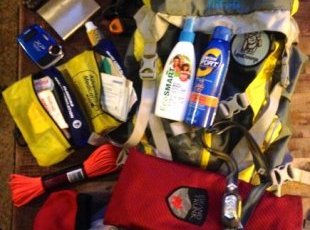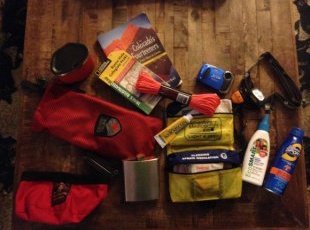Tell Us About Your Day Bag
What’s In Your Day Bag
You’re not always hiking and backpacking, as much as you wish you were. What’s in the day bag – your day bag – the one that gets you from home to work to the trail or getting the kids to their hockey game or your weekend getaway, that makes it easy to move from here to there. So what’s in your day bag?
Tell us about your Day Bag
Whether hiking, camping, or climbing at the crag or in the alpine, the 12 essentials I’ve listed below always make their way into the appropriate day bag for the adventure. For this reason, I keep the bulk of them (minus some obvious larger, more fluid items) in a single plastic bag that gets tossed from one pack to another depending on the activity. The more obvious items that aren’t included in the little grab bag are my Camelbak bladder 1.5 – 3L of water, my dog’s bowl with food and treats and of course the National Geographic’s Trail Map, which I switch out depending on where I’m headed. I’ll pick up new knives here and there or add sunscreen and toiletries if I’m feeling like spoiling myself with some comforts but most of the time I’m confident with just tossing this bag in a pack pocket.

What are your 10 essentials?
- Pocket knife- as light and sharp as possible. Right now that’s the ultralight 27 gram stainless steel pocket knife from Spyderco.
- Black Diamond headlamp with an extra three AAA batteries because you never know.
- A Bic Lighter- for those quick fire moments
- Climbers tape- great as make-shift bandages for minor cuts and even more severe lacerations. This stuff also burns really well and seconds as my fire-starter
- First Aid Kit- contents (antiseptic, alcohol, bandages, painkillers and allergy medicine) loose in a plastic bag with the addition of Chlorine Dioxide Tablets in the event I need to decontaminate some drinking water
- A National Geographic Trail Map and Compass – If you live in Colorado, don’t take off into the mountains without the one of these bad boys for the area you intend to visit. It can get you to the trail, keep you on it, and teach you to identify the landmarks around you and your position. I have a stack of them, and I’ll often pick a trail or peak off one of them at random to explore. A great way to study an area before heading out. For a compass I have the old reliable army green compass. On most outings I find the compass to be more of a toy than a necessity but I’d also never want to get lost without one. The map also can work as a poncho in extreme conditions if you find yourself without a rain jacket.
- Survival Blanket- 50 uses
- A bandanna- probably more than 50 uses
- Cell Phone- It’s incredible some of the places you can get cell phone reception these days. To leave your cell phone at home would be irresponsible in most cases. Granted, you should keep your texting, tweeting and Facebooking to a minimum (not at all) but why find yourself injured and cut off from the world in a place where you could easily use full-bars to call for help just because of your nostalgia for what could be considered wilderness before cell phones.
- All things dog- I take my black lab mix Winny with me everywhere, so I have a little go bag for her too. Silverfoot has an awesome collapsible dog bowl that I’ve been using for years. I fill it with food and some treats. The waterproof material also holds water so I add a ration for her to my Camelbak. I also throw in some climber’s balm for her paws. On rockier trails her pads will dry, crack and get chewed up pretty fast and we’ve found that the balm moistens them up and gives her some minor relief.
11. Lightweight down jacket for those times when you just need a little warmth. Most times I have my Microthermdown hooded Eddie Bauer jacket.
12. A good camera for capturing those awesome adventures in the great out doors. The new Fuji XP60 ruggedized point and shoot is a go to favorite for me. The XP60 has the all weather ability to hold up in the worst environments and the ability to take some awesome underwater photos.

What are the most frequently used items in your day bag?
The maps are indispensable and I find myself looking over them at home just as much as I use them in the hills. I love knowing where I am and being able to identify the peaks and bodies of water around me. Not only is this essential for navigation in the mountains but it’s also extremely enjoyable to learn as much as possible about an area and cultivate ideas for other adventures.
If you could add one more thing what would it be?
I just realized that I need to add some cordelette to this kit. I have plenty in my climbing bag, but it rarely makes its way into my day pack. Being such a versatile and ultralight tool, there is no reason a good cord should be left behind.
